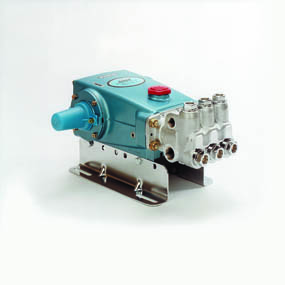What is the working principle of Liquiflo Gear Process Pumps?
Liquiflo Gear Process Pumps operate on the principle of increasing and decreasing volume. They are known as positive displacement pumps. With increasing volume, suction occurs, while with decreasing volume, discharge takes place. During operation, the pump shaft transfers the rotational motion received from the motor to the gear on the shaft (Driving Gear). The driving gear transfers its motion to the driven gear in the opposite direction, causing the gears to separate and create a vacuum at the pump’s suction port. This vacuum enables the pump to draw a certain amount of liquid into itself.
The liquid drawn into the pump moves toward the discharge port within the gear cavities, between the teeth and the pump housing. The liquid does not pass between the gears. At the discharge port, the gears mesh together, creating pressure that expels the liquid. With each revolution of the pump shaft, an amount of liquid equal to the pump’s volume is transferred.
What are the processes in which Liquiflo Gear Process Pumps are used?
Liquiflo Gear Process Pumps are primarily used in dosing, circulation, fluid transfer, and injection applications. They are employed in coating and adhesive applications for distributing the required low flow rates. Additionally, they are utilized in spray coating methods with the help of nozzles in the same processes. In the chemical industry, they are commonly used in applications requiring dosing. They are frequently encountered in the production of nitric acid, sulfuric acid, phosphoric acid, and urea-ammonium nitrate in fertilization processes.
In the food and dairy industries, they are used in canned filling processes, raw material dosing, and the distribution of cleaning chemicals in CIP systems. Beyond these applications, they are also found in various processes within industries such as iron and steel, mining, refineries, power plants, and textiles.
What are the material properties of Liquiflo Gear Process Pumps?
Liquiflo Gear Process Pumps are manufactured from 316 stainless steel, Alloy-C, Alloy-20 materials, titanium, and various corrosion-resistant materials. These materials are suitable due to their strong resistance to corrosive fluids such as polymers, solvents, acids, caustics, and their derivatives.
They are produced in H-series, 3-series, and Max-series with mechanical seals or magnetic couplings. The 4-series and 2-series are exclusively manufactured with magnetic couplings. The Poly-Guard series, a special series, is made from polymer-coated stainless steel and has high chemical resistance, making it user-friendly for the most challenging chemical processes.
What are the capacity and other operating parameters of Liquiflo Gear Process Pumps?
Liquiflo Gear Process Pumps have a wide capacity range, from 22.7 liters/hour to 12.5 m³/hour. They can withstand pressures up to 24 bar. In terms of dosing accuracy, they are highly precise, with an accuracy range of 0.5% to 2%. Liquiflo Gear Process Pumps can handle viscosities up to 100,000 cP and resist temperatures up to 260°C.
What are the advantages of Liquiflo Gear Process Pumps?
Liquiflo Gear Process Pumps are preferred by facilities for their long-standing reputation for durability and reliability, particularly in chemical dosing applications requiring high temperatures, high pressures, and low and precise flow rates. One of the most critical factors for facilities, the operating time of these pumps, is significantly longer compared to other pumps.
Liquiflo Gear Process Pumps are specifically designed for handling viscous, hot or cold, extremely fine, and corrosive chemicals, and they possess the technical capabilities to meet your specialized engineering needs. Additionally, Liquiflo Gear Process Pumps can be customized with seals, mounting, and connection configurations to best suit the requirements of various processes.
What are the accessories of Liquiflo Gear Process Pumps?
Liquiflo Gear Process Pumps provide convenience to users with various accessories. These include heat control jackets, air motors, relief valves, repair kits, various speed drives, frames, and gear reducers.
![Maxtrans_logo_beyaz[906] 1 Maxtrans_logo_beyaz[906] 1](https://maxtrans.com.tr/wp-content/uploads/elementor/thumbs/Maxtrans_logo_beyaz906-1-qig473fvjzxbg9w5l9sws4in30ncm4i7wclmuqlzdq.png)





